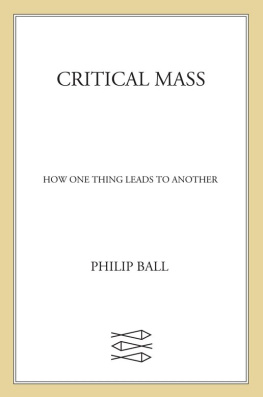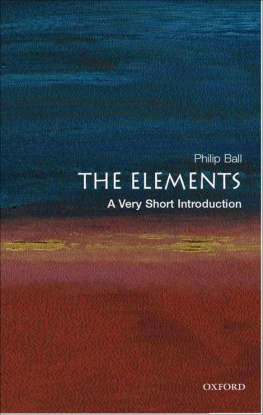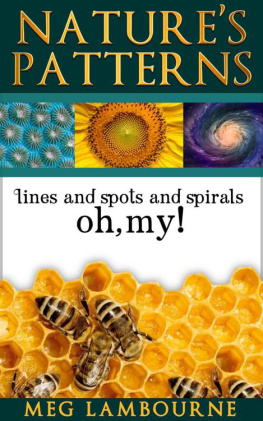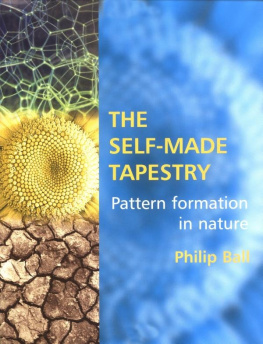Philip Ball - Shapes : Natures Patterns - A Tapestry in Three Parts.
Here you can read online Philip Ball - Shapes : Natures Patterns - A Tapestry in Three Parts. full text of the book (entire story) in english for free. Download pdf and epub, get meaning, cover and reviews about this ebook. City: Oxford, year: 2009, publisher: Oxford University Press, genre: Romance novel. Description of the work, (preface) as well as reviews are available. Best literature library LitArk.com created for fans of good reading and offers a wide selection of genres:
Romance novel
Science fiction
Adventure
Detective
Science
History
Home and family
Prose
Art
Politics
Computer
Non-fiction
Religion
Business
Children
Humor
Choose a favorite category and find really read worthwhile books. Enjoy immersion in the world of imagination, feel the emotions of the characters or learn something new for yourself, make an fascinating discovery.

- Book:Shapes : Natures Patterns - A Tapestry in Three Parts.
- Author:
- Publisher:Oxford University Press
- Genre:
- Year:2009
- City:Oxford
- Rating:3 / 5
- Favourites:Add to favourites
- Your mark:
- 60
- 1
- 2
- 3
- 4
- 5
Shapes : Natures Patterns - A Tapestry in Three Parts.: summary, description and annotation
We offer to read an annotation, description, summary or preface (depends on what the author of the book "Shapes : Natures Patterns - A Tapestry in Three Parts." wrote himself). If you haven't found the necessary information about the book — write in the comments, we will try to find it.
Shapes : Natures Patterns - A Tapestry in Three Parts. — read online for free the complete book (whole text) full work
Below is the text of the book, divided by pages. System saving the place of the last page read, allows you to conveniently read the book "Shapes : Natures Patterns - A Tapestry in Three Parts." online for free, without having to search again every time where you left off. Put a bookmark, and you can go to the page where you finished reading at any time.
Font size:
Interval:
Bookmark:
Natures Patterns

Great Clarendon Street, Oxford OX2 6DP
Oxford University Press is a department of the University of Oxford.
It furthers the Universitys objective of excellence in research, scholarship,
and education by publishing worldwide in
Oxford New York
Auckland Cape Town Dar es Salaam Hong Kong Karachi
Kuala Lumpur Madrid Melbourne Mexico City Nairobi
New Delhi Shanghai Taipei Toronto
With offices in
Argentina Austria Brazil Chile Czech Republic France Greece
Guatemala Hungary Italy Japan Poland Portugal Singapore
South Korea Switzerland Thailand Turkey Ukraine Vietnam
Oxford is a registered trade mark of Oxford University Press
in the UK and in certain other countries
Published in the United States by Oxford University Press Inc., New York
Philip Ball 2009
The moral rights of the author have been asserted
Database right Oxford University Press (maker)
First published 2009
All rights reserved. No part of this publication may be reproduced,
stored in a retrieval system, or transmitted, in any form or by any means,
without the prior permission in writing of Oxford University Press,
or as expressly permitted by law, or under terms agreed with the appropriate
reprographics rights organization. Enquiries concerning reproduction
outside the scope of the above should be sent to the Rights Department,
Oxford University Press, at the address above
You must not circulate this book in any other binding or cover
and you must impose the same condition on any acquirer
British Library Cataloguing in Publication Data
Data available
Library of Congress Cataloging in Publication Data
Data available
Typeset by SPI Publisher Services, Pondicherry, India
Printed in Great Britain
on acid-free paper by
Clays Ltd., St Ives plc
ISBN 9780199237968
1 3 5 7 9 10 8 6 4 2

THERE is beauty to be found in regularity: the same element repeating again and again, typically with geometric order. There is no better example than the honeycomb, a miracle of hexagonal perfection. This sort of pattern is a lattice. On a leopards pelt, the lattice melts but a pattern remains: spots spaced at more or less equal distances but no longer in neat rows. There is a comparable order in stripes and concentric bands: a succession rather strictly enforced on the angelfish, but more loosely applied in the meandering, merging stripes of the zebra or of sand ripples. The means by which these natural patterns are constructed may tell us something about how the far more complicated forms of animals and plants are created by a progressive division and subdivision of space, orchestrated by nothing more than simple physical forces.

Pattern and Form
Building with Bubbles
Stripes in a Test Tube
Hiding, Warning, and Mimicking
Crystal Communities
The Mathematics of a Daisy
The Formation of Body Plans

AFTER my 1999 book The Self-Made Tapestry: Pattern Formation in Nature went out of print, Id often be contacted by would-be readers asking where they could get hold of a copy. That was how I discovered that copies were changing hands in the used-book market for considerably more than the original cover price. While that was gratifying in its way, I would far rather see the material accessible to anyone who wanted it. So I approached Latha Menon at Oxford University Press to ask about a reprinting. But Latha had something more substantial in mind, and that is how this new trilogy came into being. Quite rightly, Latha perceived that the original Tapestry was neither conceived nor packaged to the best advantage of the material. I hope this format does it more justice.
The suggestion of partitioning the material between three volumes sounded challenging at first, but once I saw how it might be done, I realized that this offered a structure that could bring more thematic organization to the topic. Each volume is self-contained and does not depend on one having read the others, although there is inevitably some cross-referencing. Anyone who has seen The Self-Made Tapestry will find some familiar things here, but also plenty that is new. In adding that material, I have benefited from the great generosity of many scientists who have given images, reprints and suggestions. I am particularly grateful to Sean Carroll, Iain Couzin, and Andrea Rinaldo for critical readings of some of the new text. Latha set me more work than Id perhaps anticipated, but I remain deeply indebted to her for her vision of what these books might become, and her encouragement in making that happen.
Philip Ball
London, October 2007
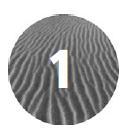
Pattern and Form
ARRIVING on Earth, the aliens approach the first thing they see and utter the familiar words: take me to your leader (). Like many jokes, this one offers a damning critique. It undermines the venerable and serious scientific quest to find life on other worlds, exploding the question of how would we know if we found it? by answering that we tend to imagine it will look like us.
Now, let me assure you that astrobiologists (as scientists who study aliens are called nowadays) are not really that foolish. They do not imagine for a moment that when we touch down on another inhabited world, we will be greeted by envoys who look like Leonard Nimoy. Indeed, if there is life in those parts of our own solar system that seem at all habitable (such as the subsurface seas of Jupiters icy moon Europa), it is most unlikely to warrant the description intelligent. And we may have to look hard and long to find it, precisely because we dont know what were looking for. Yet even if we know it is not going to be Dr Spock, we have trouble shaking the conviction that it will look something like the forms of life we have seen before.

Fig. 1.1: Do we inevitably expect life to look like us?
). But scientists have a rather more sophisticated view of life (although they still cannot agree on a universal definition of it), which gives them hope of distinguishing it from its inorganic context. They recognize some attributes of living systems that go beyond mere physical appearance, such as the fact that life tends to destroy the chemical equilibrium of its environment. Ill explain later what I mean by that, but lets say for now that its rather like watching a film in which all you can see are balls being juggled: you know that there is something out of frame that is keeping them in motion. Its true that some geological and astrophysical processes that dont involve life at all can also induce this disequilibriumbut nonetheless, searching for disequilibrium as a potential fingerprint of life seems a lot better than looking around for a loitering humanoid alien to whom you can say Take me to your leader.
Next pageFont size:
Interval:
Bookmark:
Similar books «Shapes : Natures Patterns - A Tapestry in Three Parts.»
Look at similar books to Shapes : Natures Patterns - A Tapestry in Three Parts.. We have selected literature similar in name and meaning in the hope of providing readers with more options to find new, interesting, not yet read works.
Discussion, reviews of the book Shapes : Natures Patterns - A Tapestry in Three Parts. and just readers' own opinions. Leave your comments, write what you think about the work, its meaning or the main characters. Specify what exactly you liked and what you didn't like, and why you think so.




